This post may contain affiliate links. Please see our disclosure policy.
Canning mushroom soup base is a great way to have the beginning of a great meal in a jar.
While you can’t process cream or thickeners, you can preserve everything else in a jar right on your pantry shelf. It’ll be ready when you need it, whether you’re eating it as a mushroom soup or incorporating it into other recipes.

Canning cream of mushroom soup is a great way to make use of your pantry ingredients and have dinner ready in no time. Not to mention it’s a delicious dish that never gets old!
This popular recipe brings together creamy mushroom soup and the convenience of being able to store it for up to two years due to the canning process.
From its many uses in thick cream-based soups, to heart casseroles and even a meal in and of itself, there’s something for everyone when it comes to canned cream of mushroom soup.
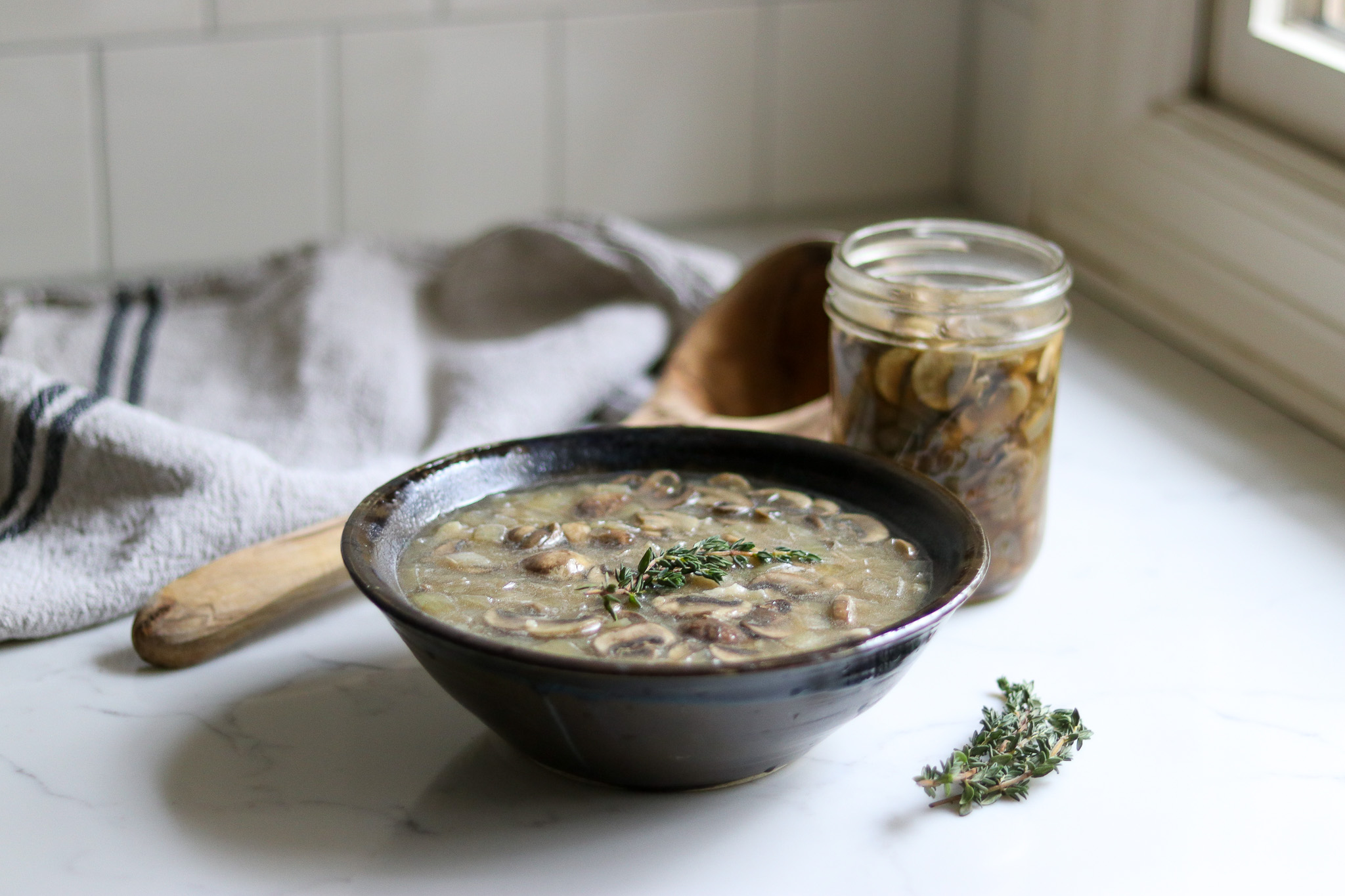
First things first, it’s important to note that, when you make this recipe, you won’t necessarily be canning the cream of mushroom soup, but instead, you’ll be canning the base. That’s because it’s unsafe to do anything with cream or added thickeners included in it.
Nevertheless, it doesn’t take long to add the cream once you’ve opened a jar of this tasty base.
It has everything in it except cream and thickeners, which are easy to add when you heat it up.
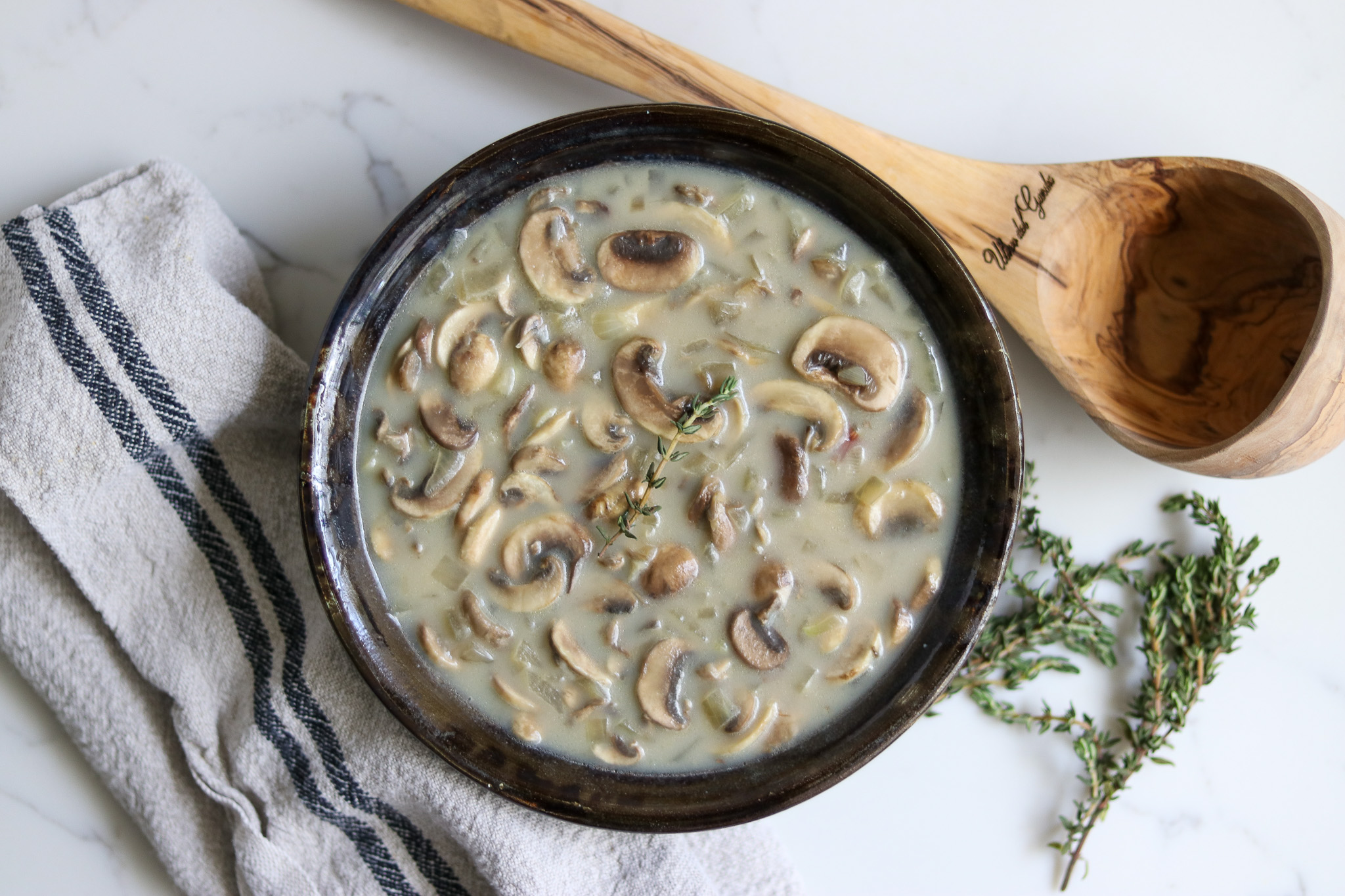
Ingredients for Cream of Mushroom Soup
This recipe is adapted from Pressure Canning for Beginners and Beyond by Angi Schneider, my favorite pressure canning book. In fact, I looked through all my canning books, and hers was the only one with instructions for canning cream of mushroom soup base.
To make this recipe, she’s basing it on the National Center for Food Preservation’s recommendations for canning mushrooms and adjusting it based on allowed variations.

Instead of water, she’s using white wine and chicken stock, which are both fine for pressure canning. Chicken stock processes for 20 minutes in pints, so that’s much less than the 45 minutes used for mushrooms.
She’s also adding onions and a few cloves of garlic.
Onions are safe for canning, and the national center for food preservation puts their process time at 40 minutes, which is again, less than the time for mushrooms.
And you are allowed to add a few cloves of garlic to pressure canning recipes without impacting safety, so the garlic is fine too.
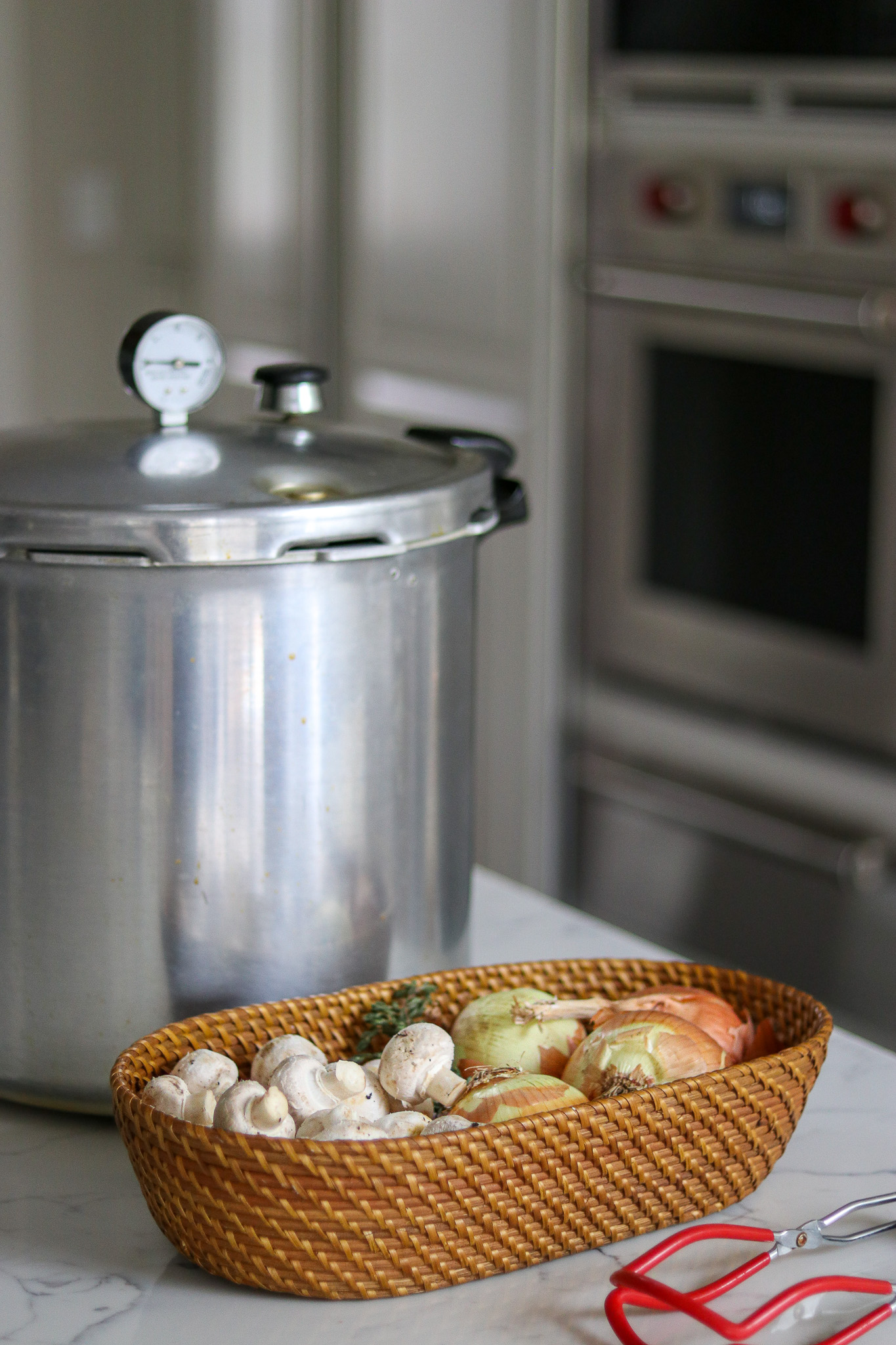
Dry spices are allowed in reasonable amounts, meaning they don’t turn the whole thing into a spice paste…so a few teaspoons of black pepper and thyme safe to add as well.
The one thing I will note is that this recipe made a bit less than the original recipe states, so I increased the broth and wine used in the recipe. She notes that if you’re short to fill your jars, you can add boiling water…but I’d rather have more flavorful stock and wine instead.
Be sure to evenly distribute all the solids across all eight pint-sized canning jars, and then top them with broth, so each of your jars gets the same amount of solids.
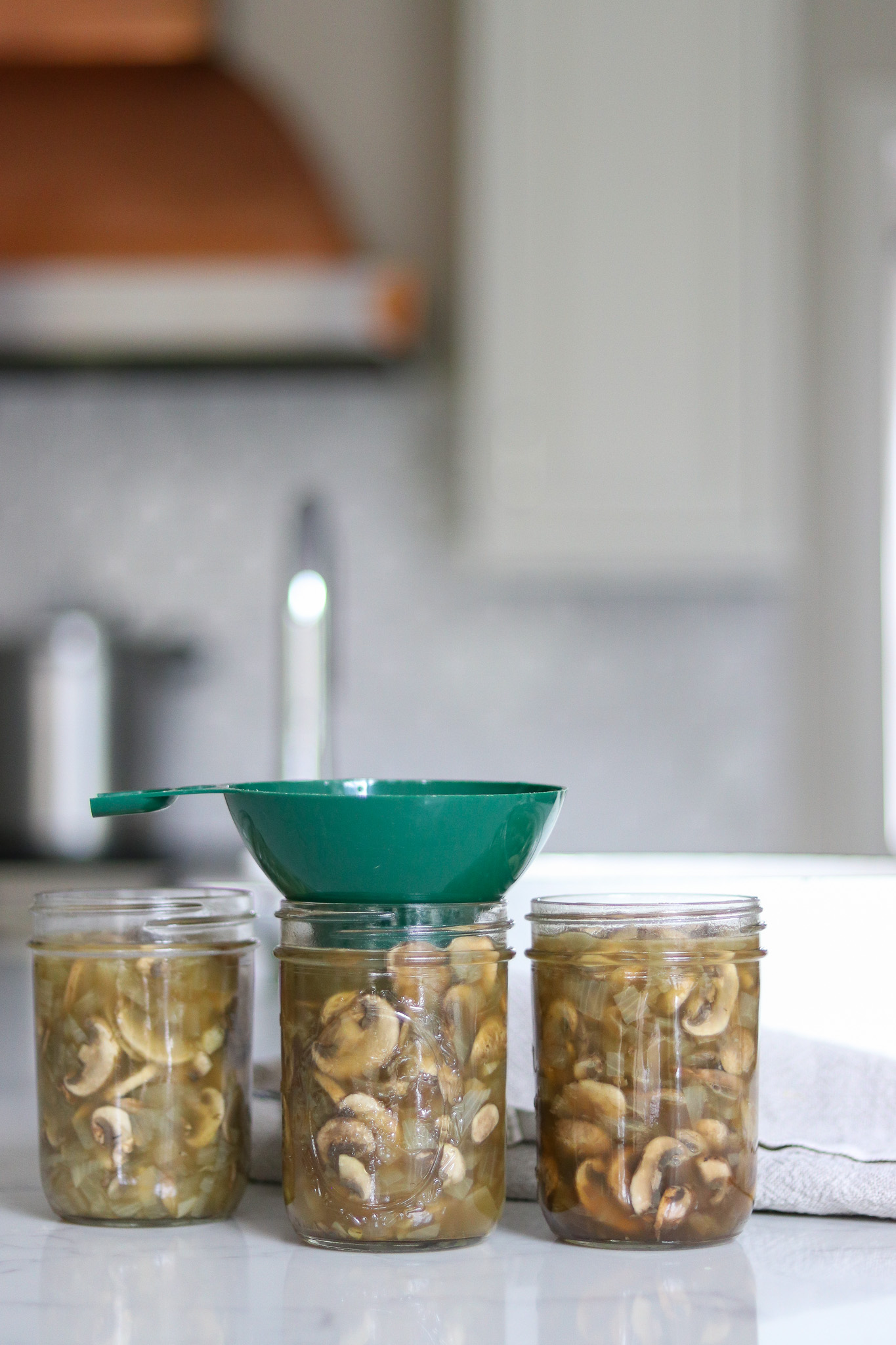
To make a canner batch of 8-pint jars, you’ll need the following ingredients:
- 4 tbsp (56 grams) butter
- 2 lbs (900 grams) mushrooms of your choice, thinly sliced
- 6 cloves of garlic, minced
- 8 cups (770 grams) of minced onions (about 2 ¼ lbs or 1 kg of whole onions)
- 1 cup (240 ml) dry white wine
- 8 cups (1.9 liters) chicken or beef broth
- 4 tsp (24 grams) of non-iodized salt (like sea salt or canning salt)
- 1 tsp (5 grams) ground black pepper
- 2 tsp (2 grams) dried thyme
- Boiling water to fill (may not be necessary, see notes)
This recipe uses 4 tsp of salt, which helps bring out the flavor of the mushrooms. The salt is added for flavor, not preservation, and you can reduce (or increase) the amount based on your preference.
I’m using canning salt, which is an additive-free salt for canning. Other additive-free salts like sea salt, Himalayan salt, and kosher salt also work. Don’t use iodized salt, as it contains additives.
I have a guide to canning salt and alternatives if you want other options.

Upon serving, you will also add, per each 1 pint (500 ml) jar:
- ¼ cup (60 ml) heavy cream
- 1 tbsp (8 g) of flour for thickening
- Fresh thyme or parsley, to taste
You can use any type of mushrooms and onions that you like for this recipe, provided they’re cultivated mushrooms rather than wild. Making sure the quantities are correct is the most important part.
Wild mushrooms are not tested for canning, at least at this point.
Be sure not to add the last three ingredients (particularly the cream and flour) until after canning, directly before you intend to serve the cream of mushroom soup.
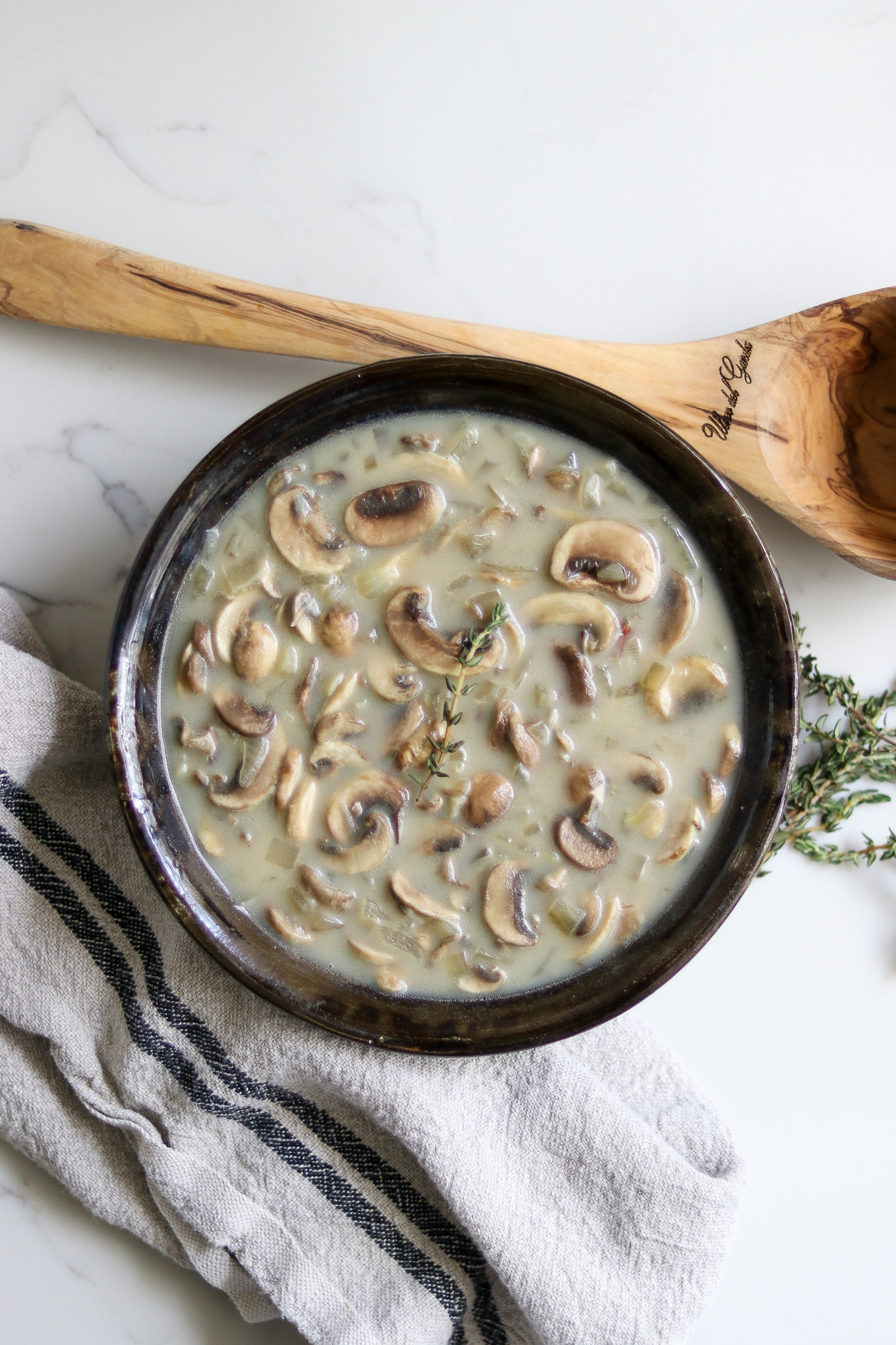
Jar Sizes for Canning Mushrooms
The other thing that’s really important to note here is that there are no tested recipes for canning mushrooms in quarts, so this recipe must be done in pint jars.
Instructions from the national center for food preservation actually explicitly warn against canning mushrooms in quarts, largely because they haven’t tested that variation. Both half pints and pints are canned for 45 minutes, but there are no recommendations for quarts.
This cream of mushroom soup base can only be canned in pints (or smaller).
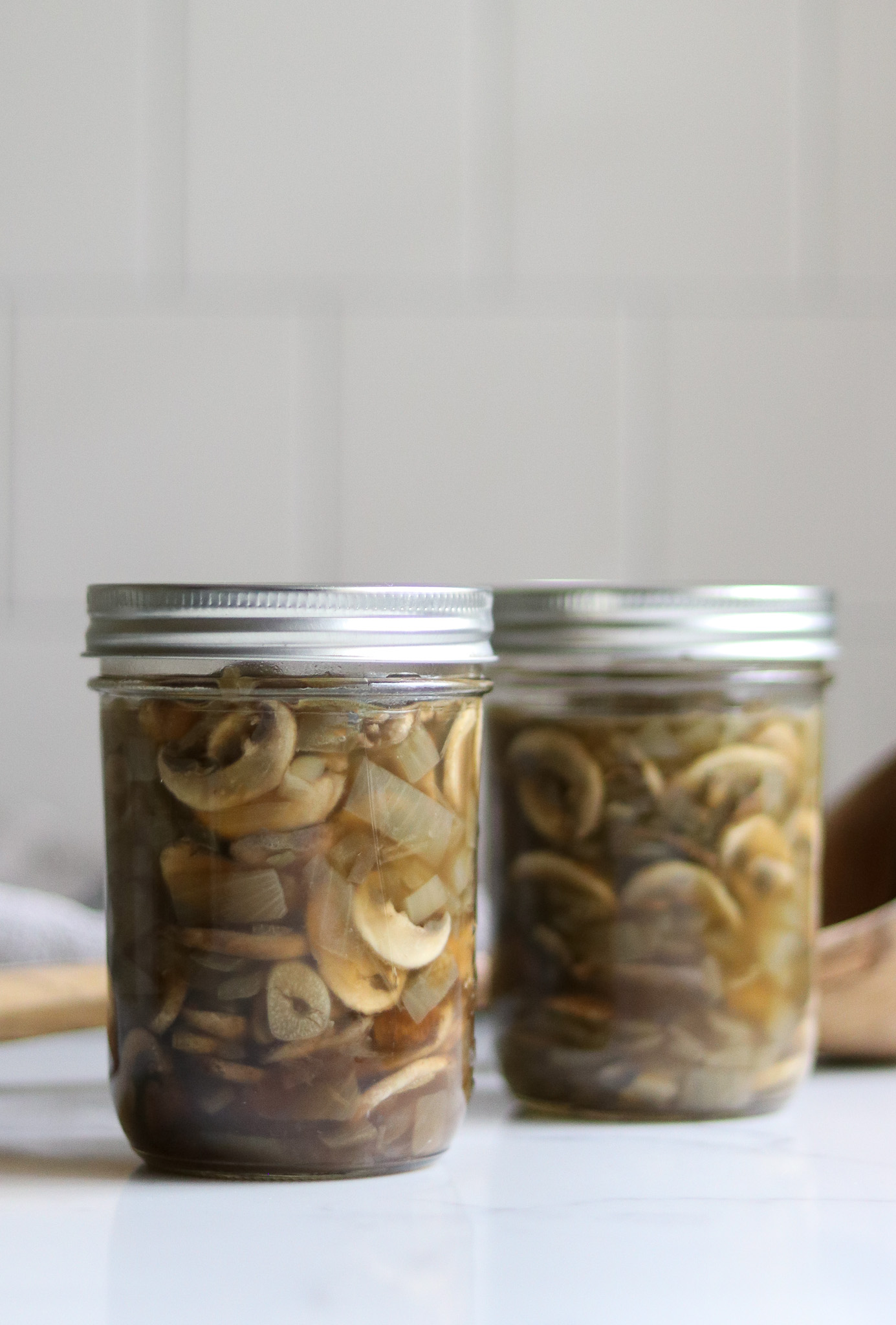
Canning Cream of Mushroom Soup
Begin by preparing your equipment, including the jars, lids, and pressure canner. For this recipe, you will need eight 1-pint jars (500 ml).
Note that there is no approved recipe for canning cream of mushroom soup in quart jars, so pints it must be!
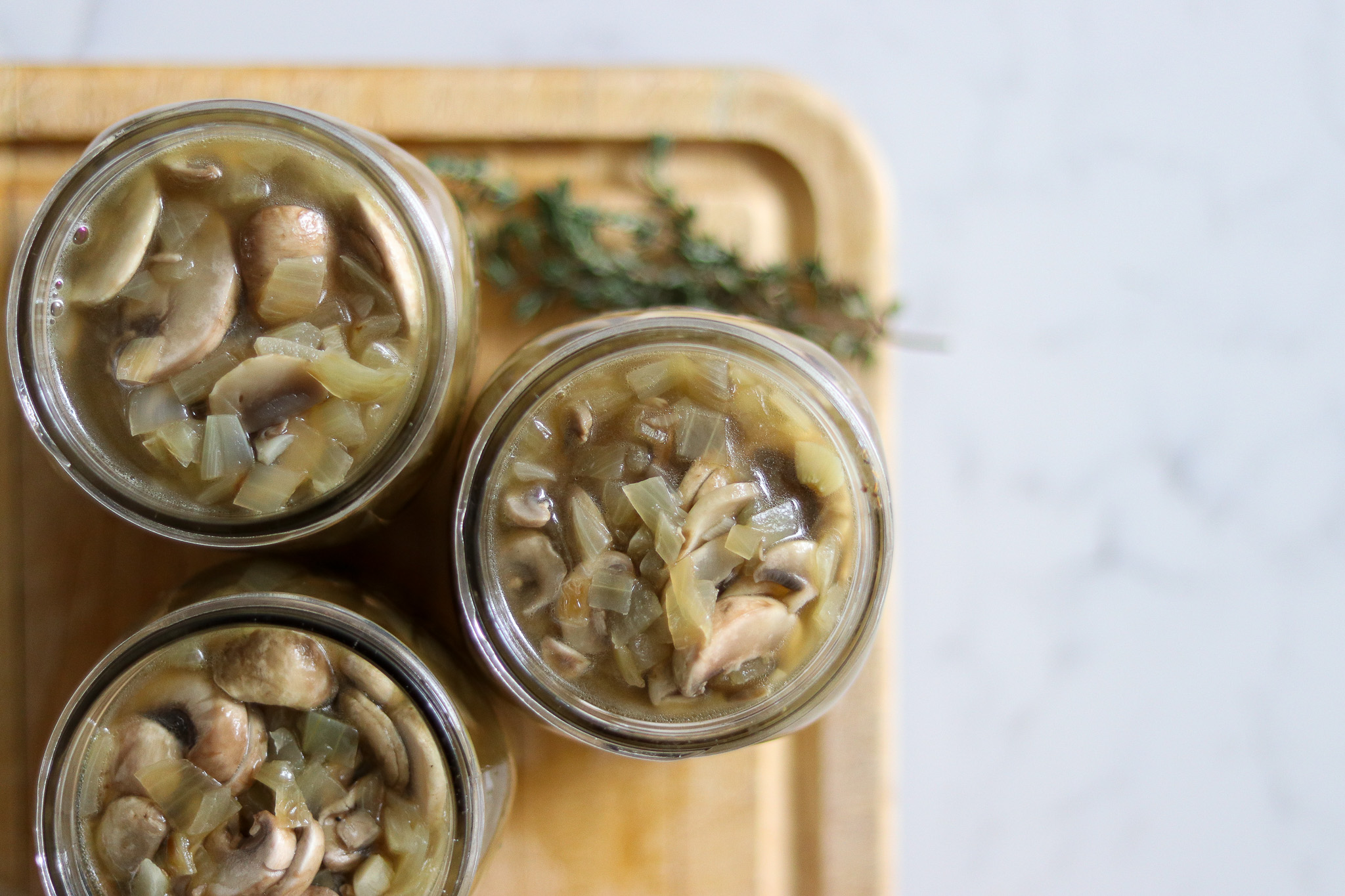
Fill the canner with a few inches of water, based on the instructions from your manufacturer, then put it on low heat with sterilized jars inside. This will keep the jars hot and make your work a little easier later on.
It’s important to heat the canner up ahead of time, since this is a hot-pack recipe. The canner needs to be about 180 degrees Fahrenheit (or 82 degrees Celsius) as soon as you start the process.

While the canner is heating up, prepare the vegetables. The onions should be diced, and the mushrooms sliced.
Use a large stockpot to melt the butter and saute the onions and garlic over medium heat. It should take about 15 minutes, at which time the onions will be translucent and soft.
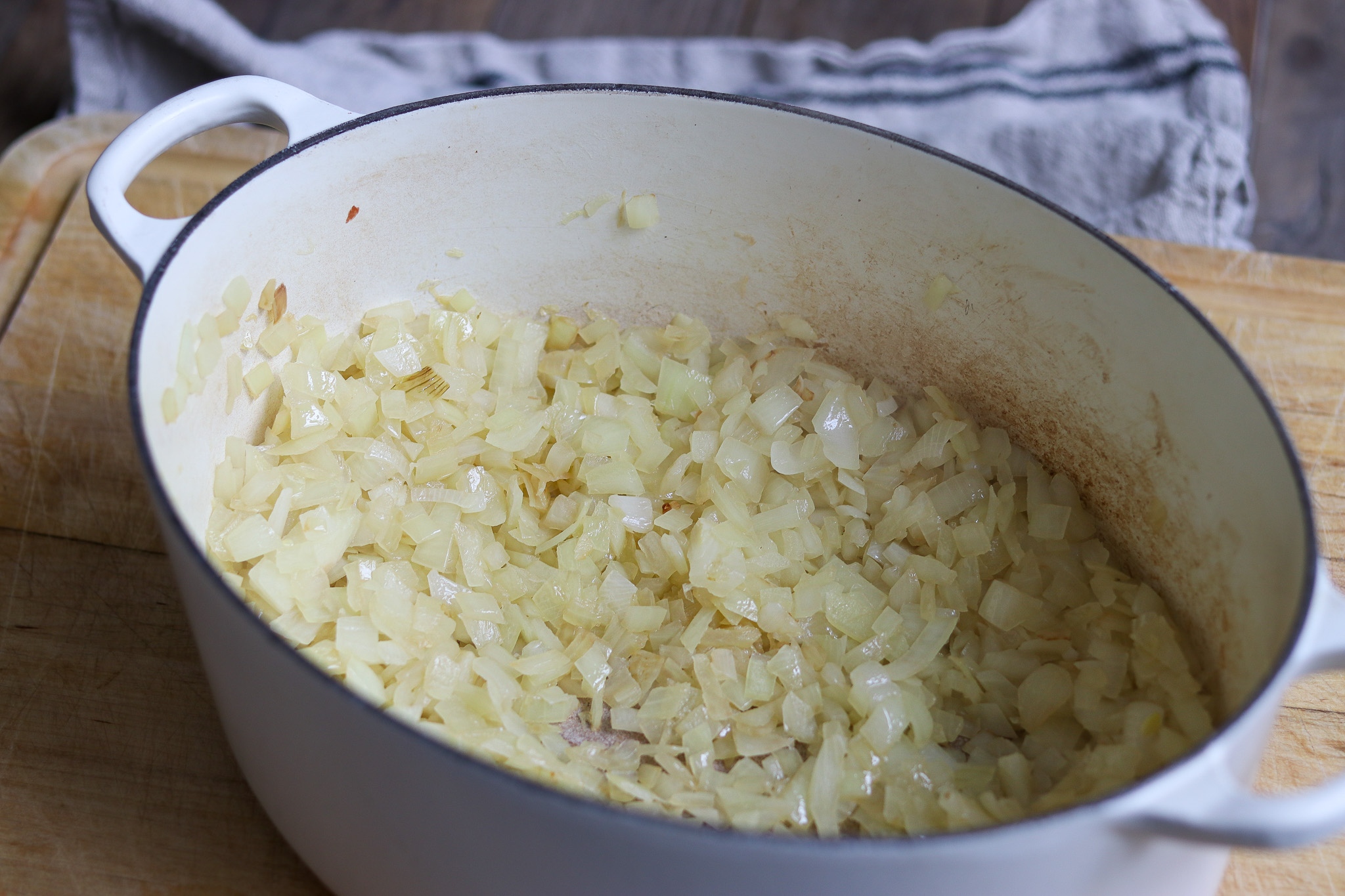
After the onions are translucent, add the mushrooms and sautee those for a few minutes to lightly brown.
Give it all a stir to get everything well incorporated.
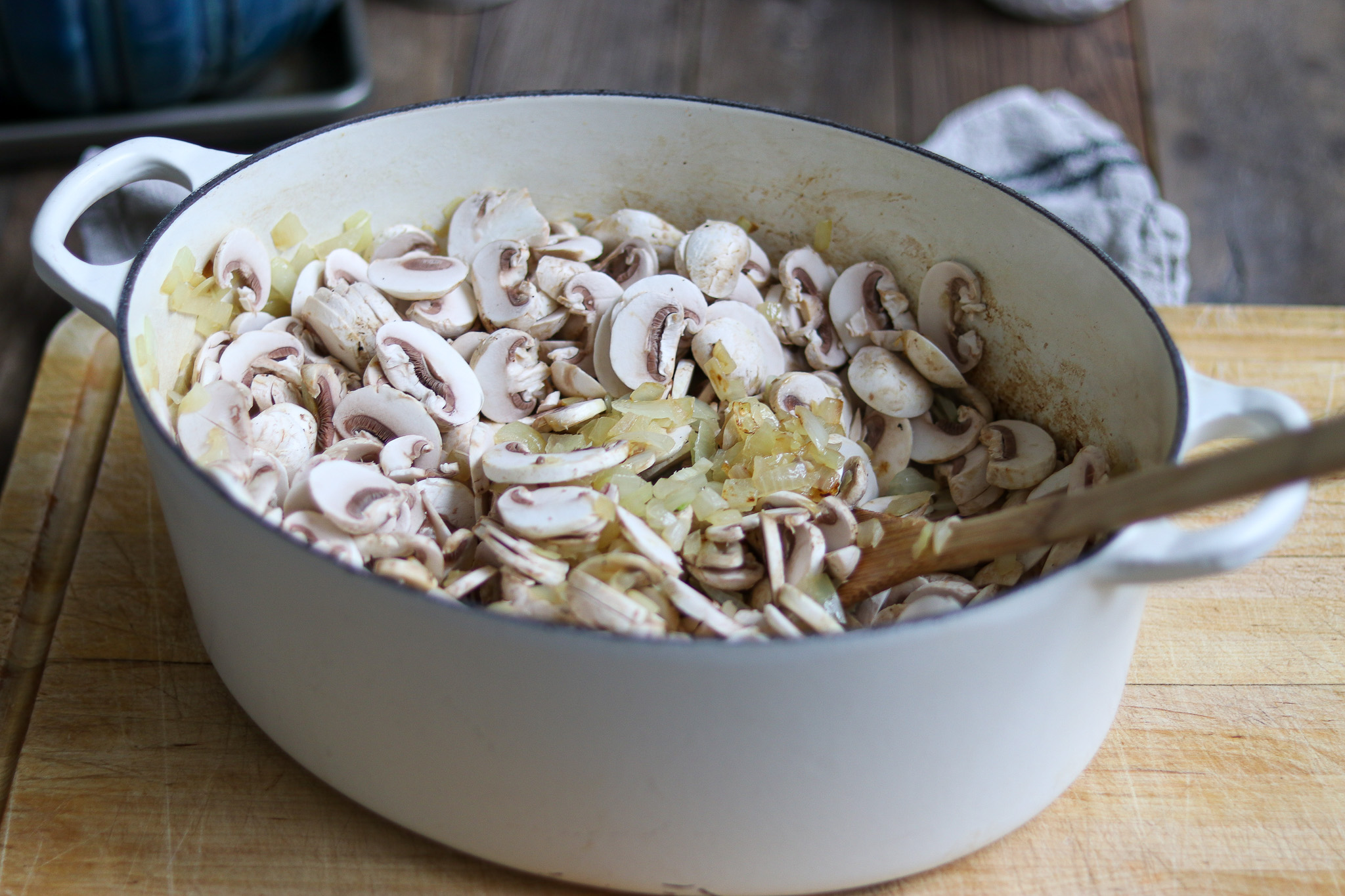
Next, add the broth and wine, along with the spices, to the pot.
You can omit the wine and use all stock if you’d like, but I really do think the wine adds excellent flavor to this mushroom soup base.
If you don’t want to use wine, add an extra cup of broth or water instead.
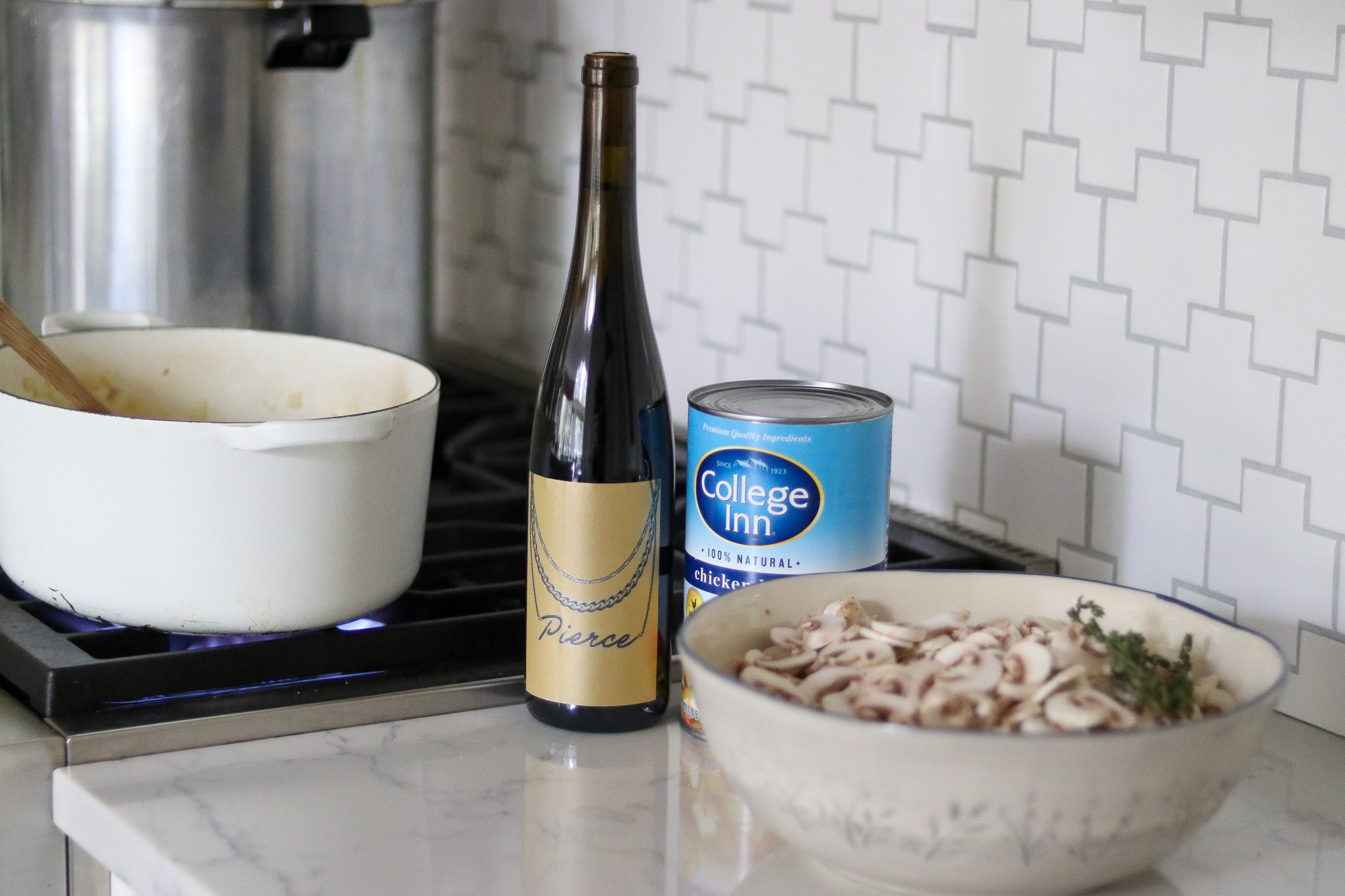
Bring everything to a boil over medium-high heat. This should be relatively quick, as the pot and mushroom/onion mix was already hot.
Wait until the mixture is boiling well, and then set a timer for 5 minutes. Everything needs to boil for 5 minutes to drive off air from the mushroom’s tissues, and so everything is evenly heated before packing into jars.
Don’t skip the 5-minute boil.
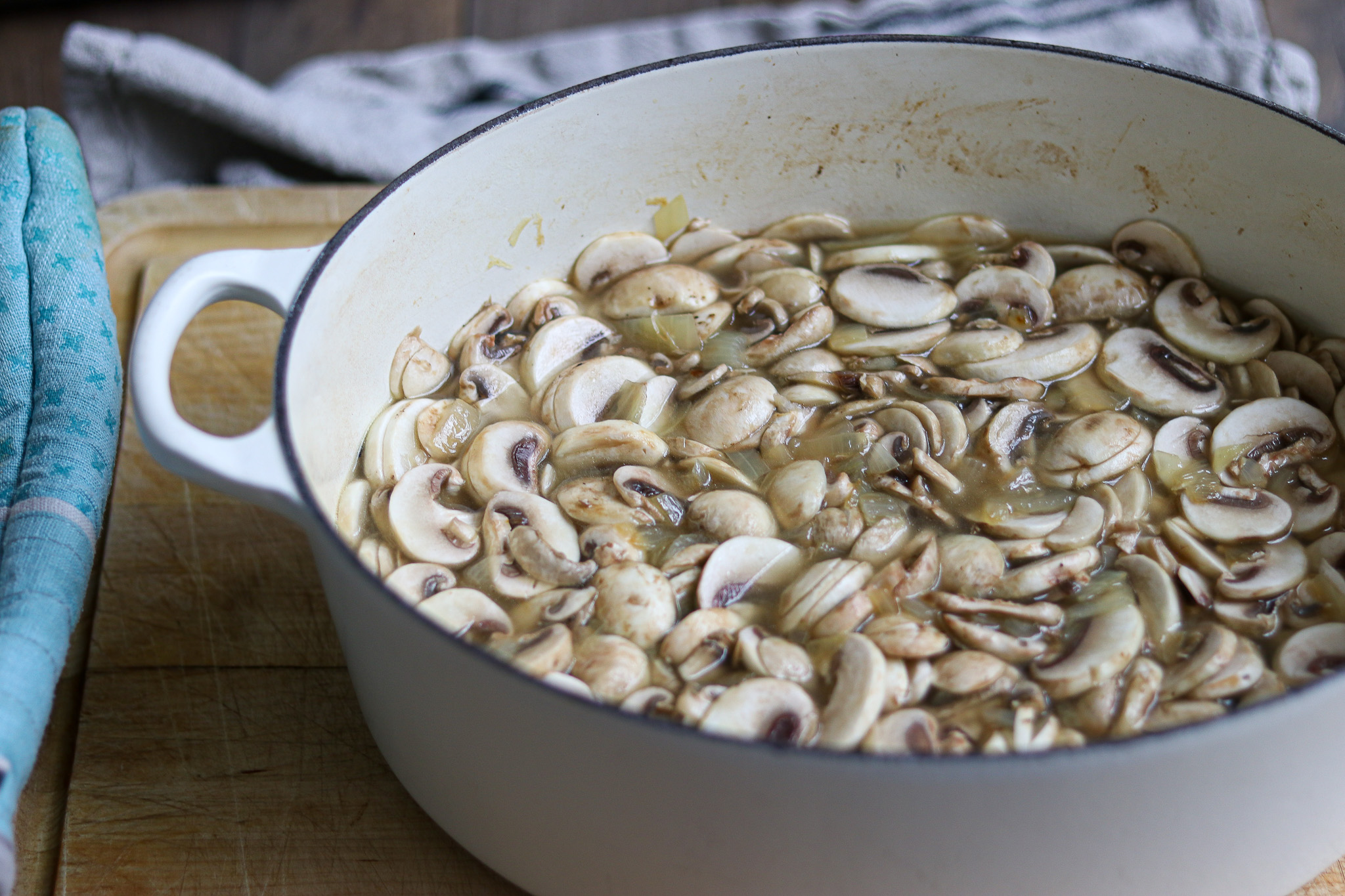
Remove the pot from the heat and ladle soup into the hot jars.
Try to ladle the solids into the jar first, so each one has roughly the same amount, then divide the liquid evenly among them.
This is important. The recipe should yield 8 pint jars, and they may or may not be all the way full to the top with solids, depending on how much your mushrooms have shrunk during cooking.
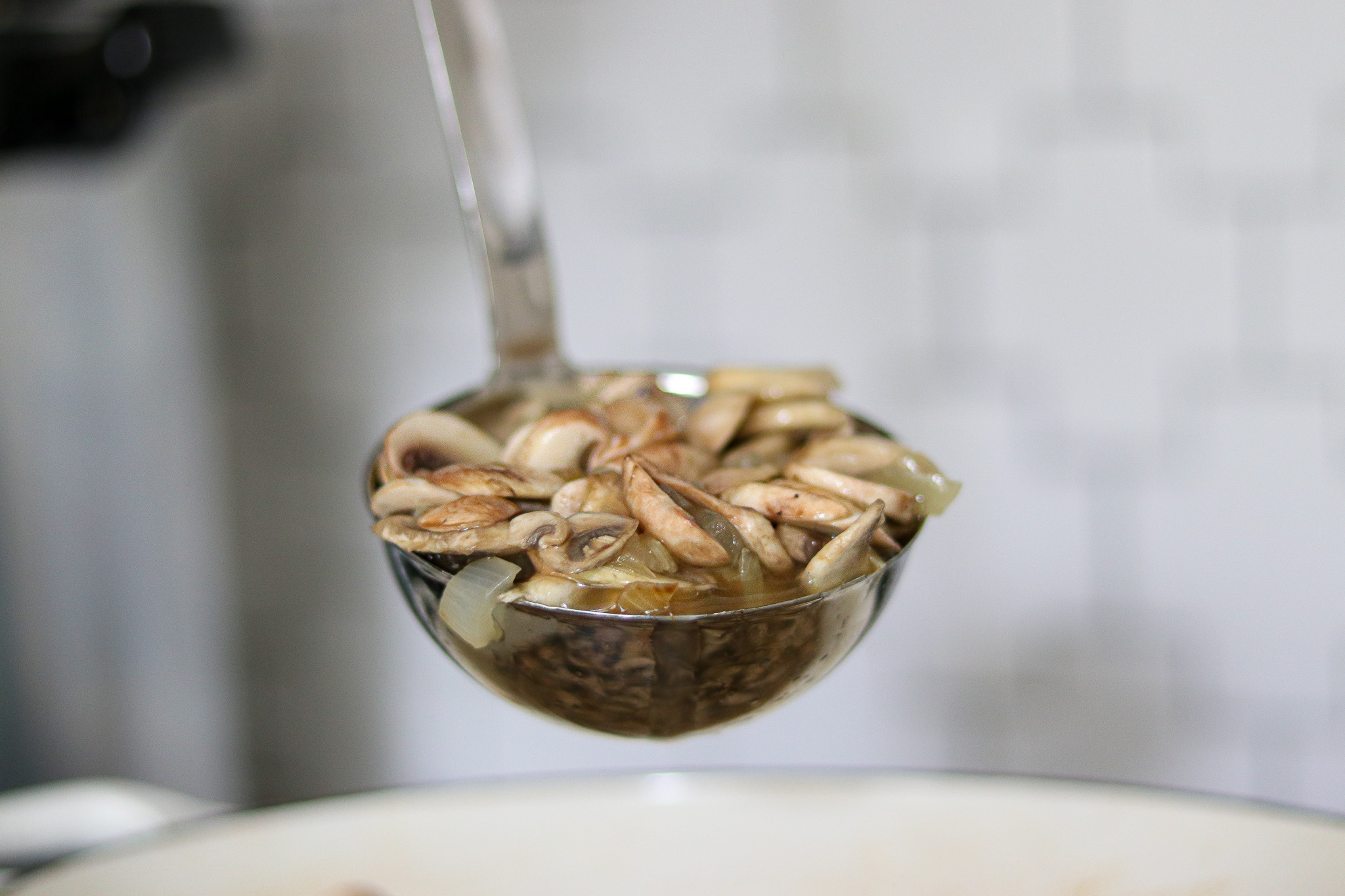
Leave 1″ (2.5 cm) of headspace.
The headspace is important because it helps prevent siphoning or liquid loss during canning. It’s enough space to prevent the contents from bubbling up and messing with the seal, but not so much space that the jar will have trouble vacuuming sealed during the canning time.
Be sure to measure headspace, as it does matter for canning.
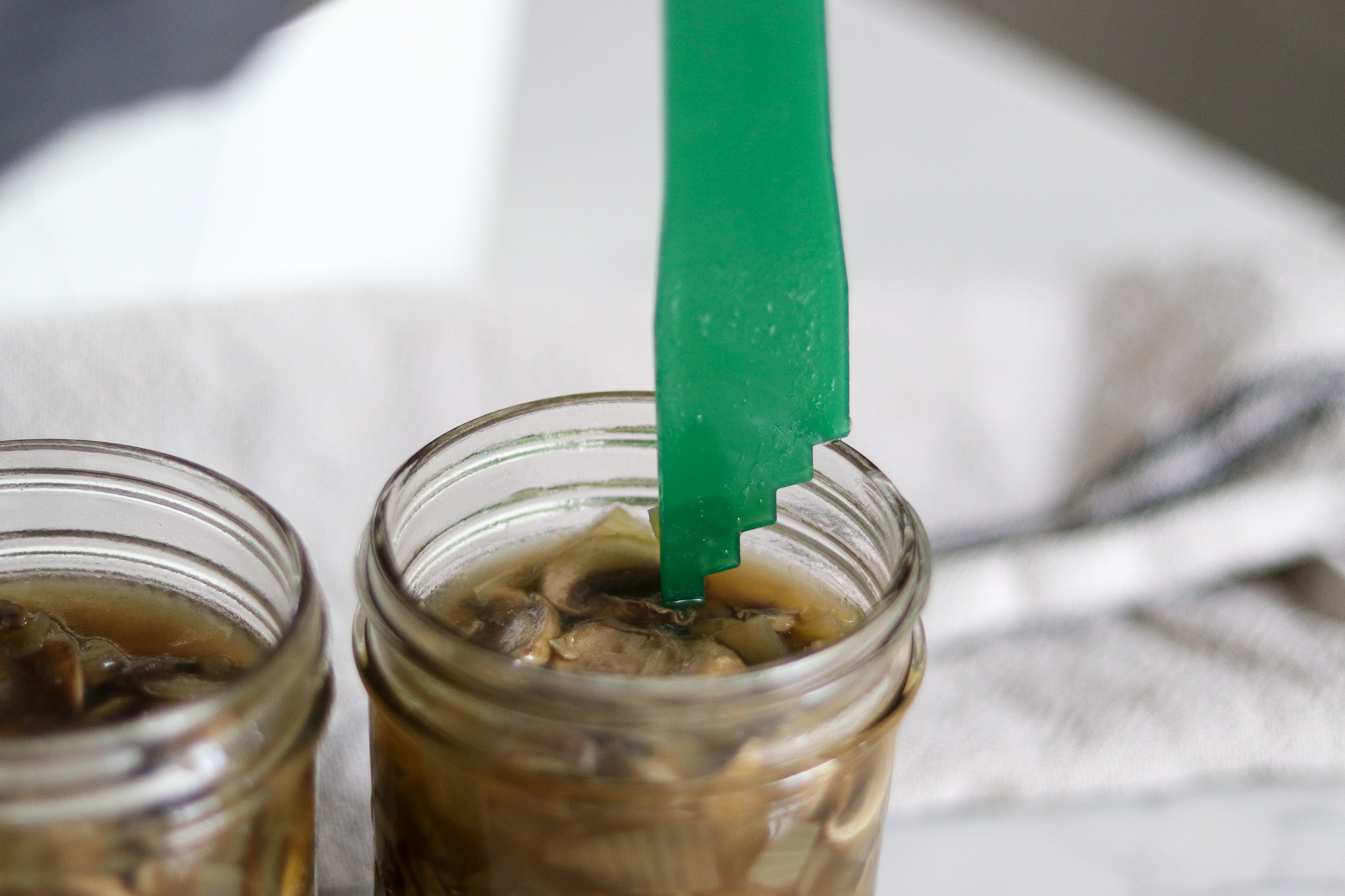
Remove the bubbles with a bubble removal tool. Double-check that the headspace is still correct.
If you find that the jars are a little scant on liquid, you can add more of the broth or boiling water.
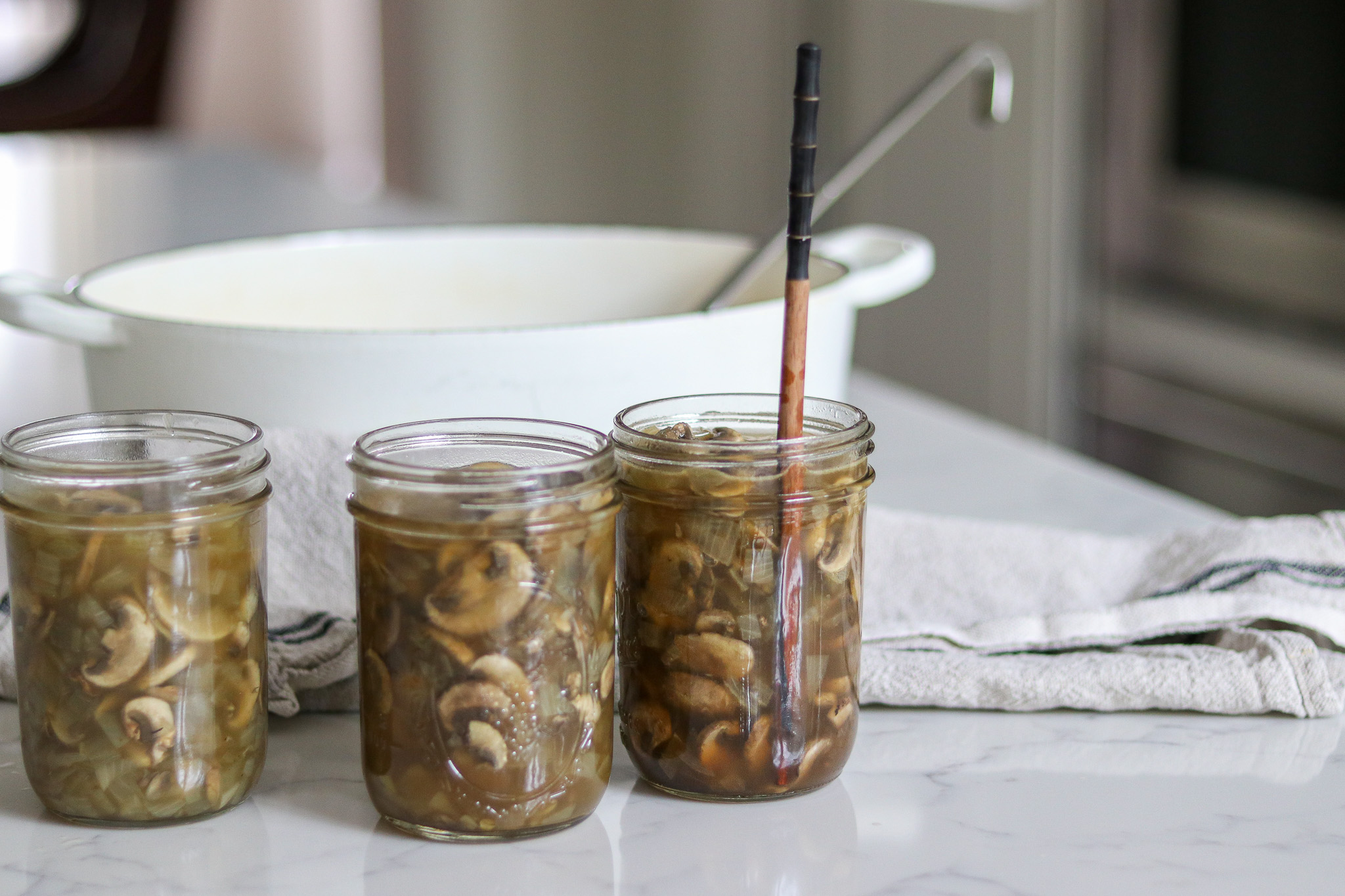
Wipe the rim of each jar with a clean cloth, then put the lids and bands onto the jars. Tighten until they are fingertip tight, then load into the pressure canner.
Process the jars at 10 lbs of pressure for 45 minutes. You may need to adjust for altitude or based on the recommendations of your canner manufacturer. See the instructions below for altitude adjustments.
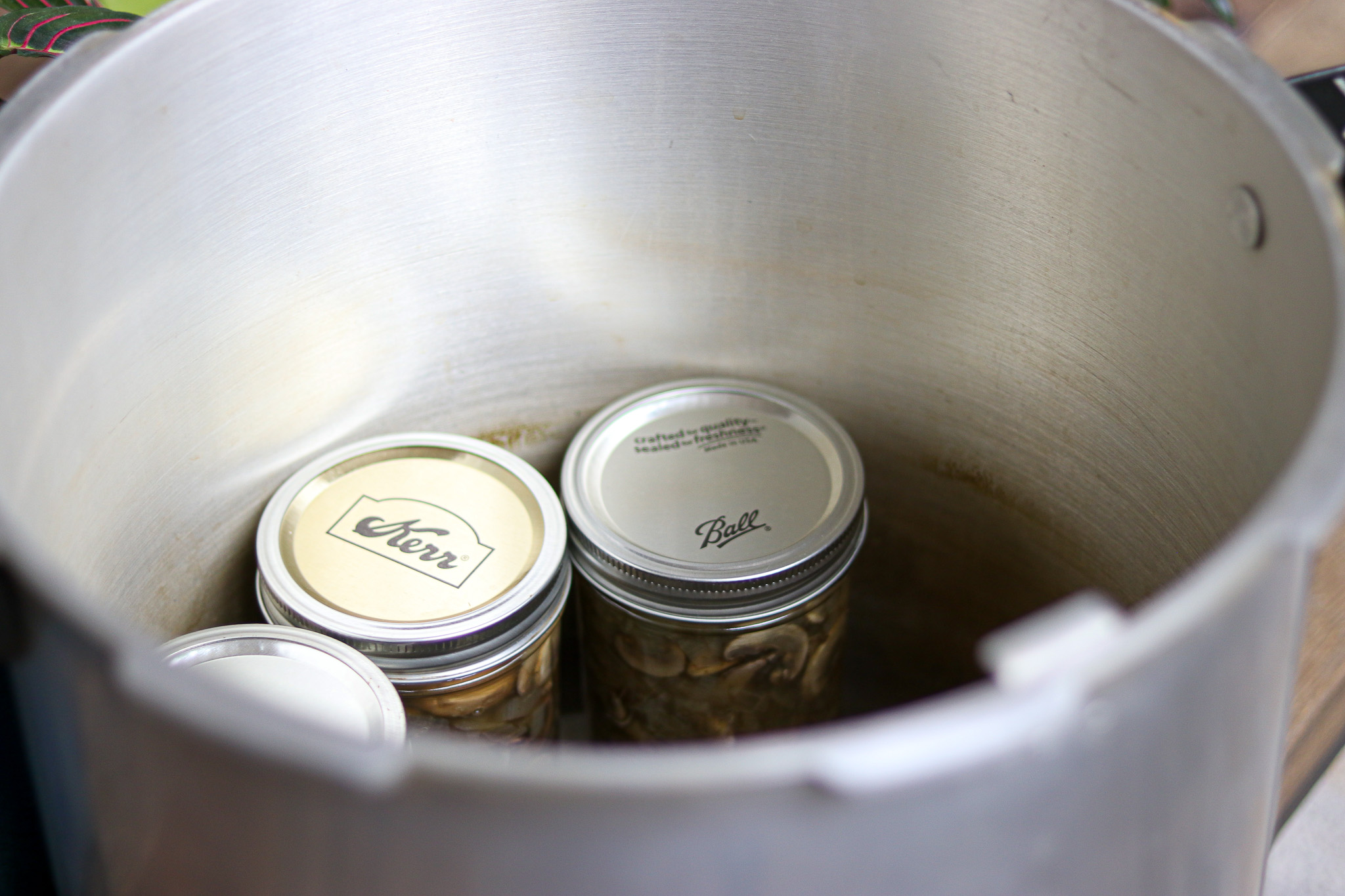
After processing, let the canner depressurize on its own. Then, remove the jars and allow them to cool for at least 12 hours before storing them.
Check the seals and store your jars for up to 12 months.
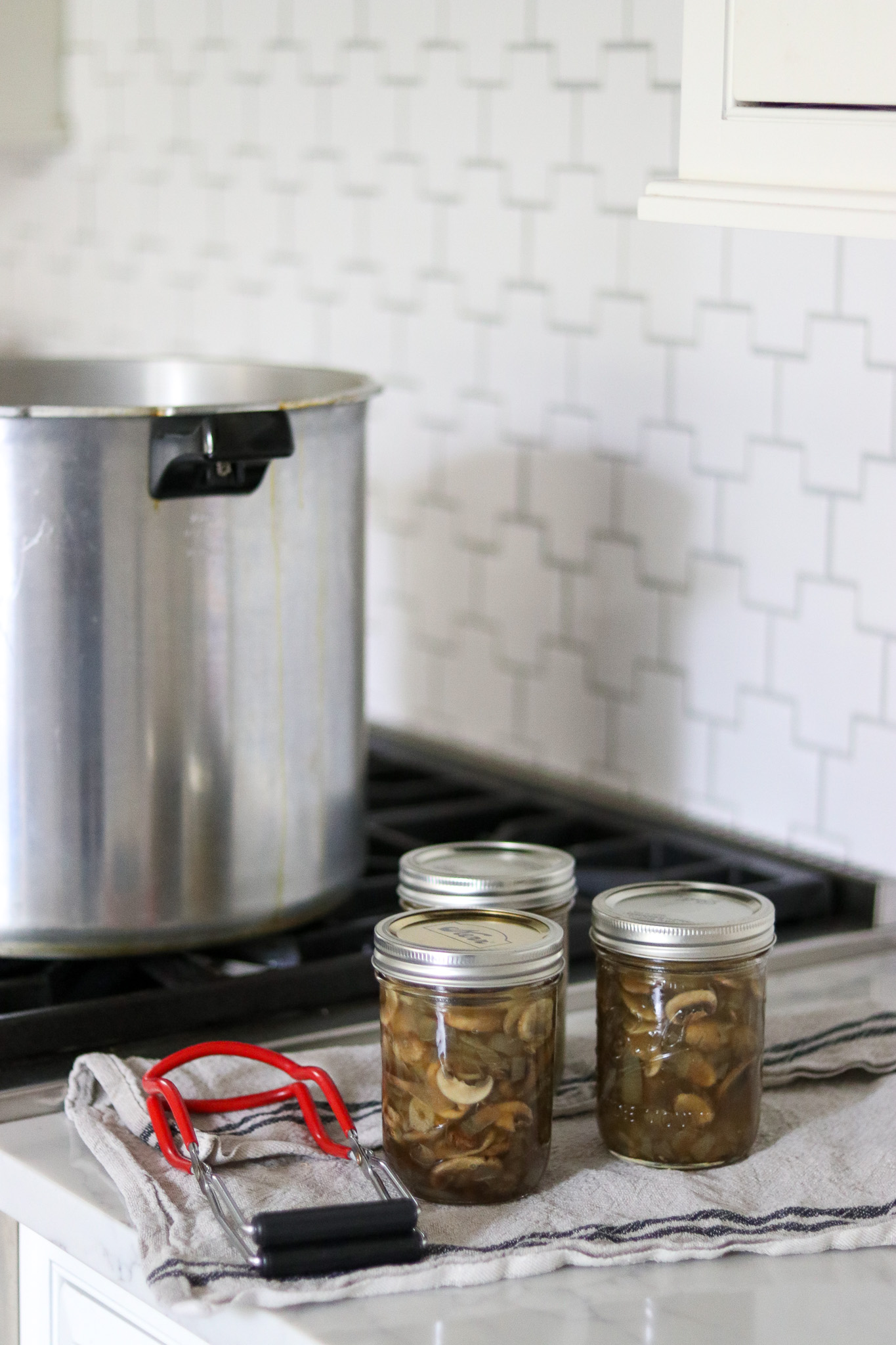
Altitude Adjustments for Canning Soup
Canning time remains the same regardless of altitude. However, the processing pressure increases as altitude increase.
Use the following table to determine the correct processing pressure if you’re above 1,000 feet in elevation.
For dial gauge pressure canners:
- 0 to 2,000 feet in elevation – 11 lbs pressure
- 2,001 to 4,000 feet in elevation – 12 lbs pressure
- 4,001 to 6,000 feet in elevation – 13 lbs pressure
- 6,001 to 8,000 feet in elevation – 14 lbs pressure
For weighted gauge pressure canners:
- 0 to 1,000 feet in elevation – 10 lbs pressure
- Above 1,000 feet – 15 lbs pressure

Mushroom Soup Base Variations
Mushroom soup is endlessly adaptable, and you can use any type of cultivated mushrooms. This includes oyster mushrooms, and any other culinary mushrooms that were grown for eating. (Don’t use wild mushrooms, they haven’t been tested for canning.)
You can give this recipe an Asian flare by using shiitake mushrooms and seasoning with soy sauce instead of herbs and salt.
Try using a bit of port or sherry instead of white wine, and experiment with different dried herbs and seasonings.
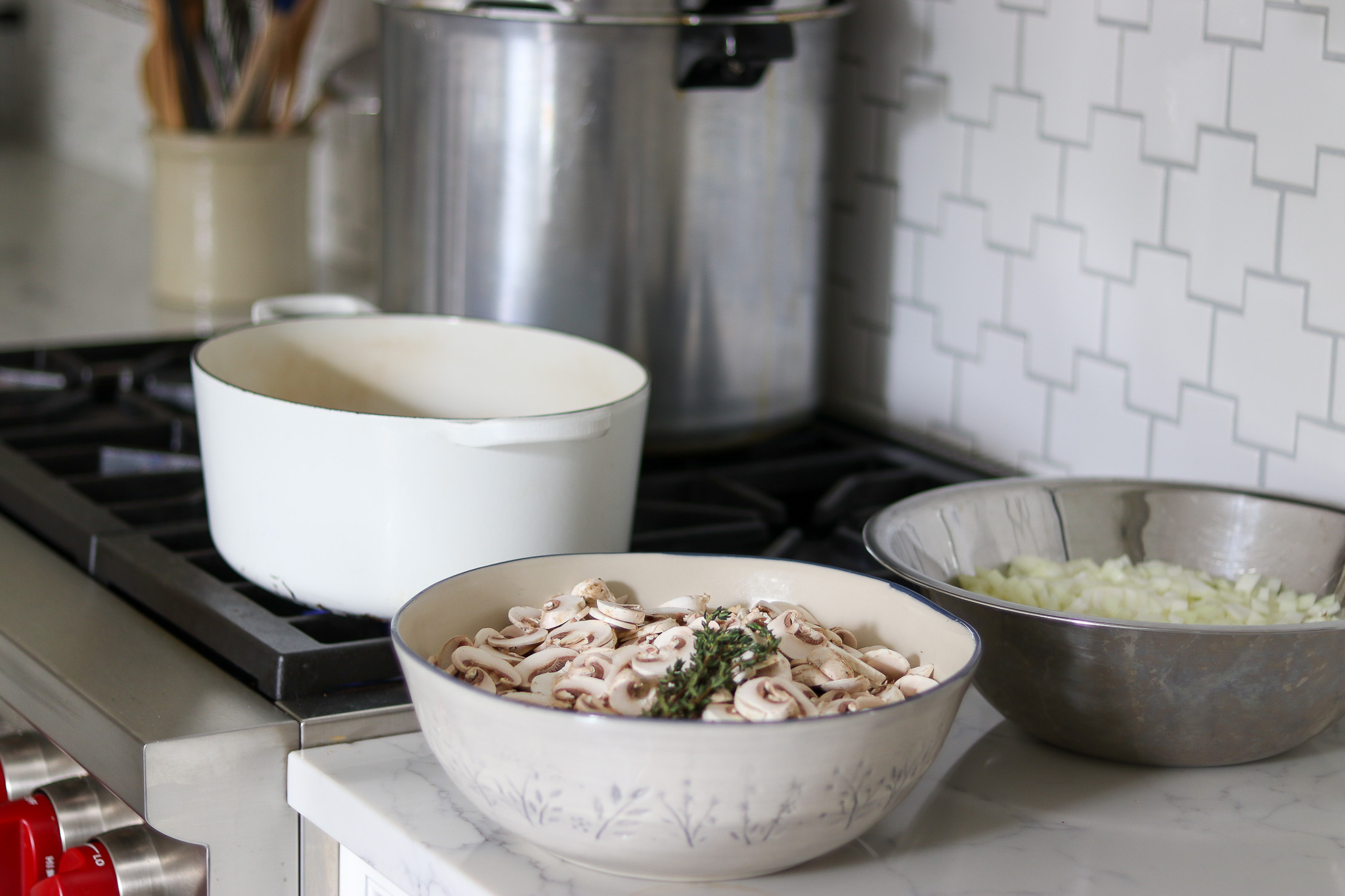
Serving Cream of Mushroom Soup
To serve your soup, pour into a medium stock pot and heat it over medium heat for about 10 minutes, or until bubbling. Then, add the remainder of the ingredients (the cream and a flour slurry) to thicken the soup.
Bring the soup back to a boil and cook for another minute or two to allow it to thicken up, being sure to stir it throughout the process. Garnish with thyme or parsley and serve with fresh bread or salad.
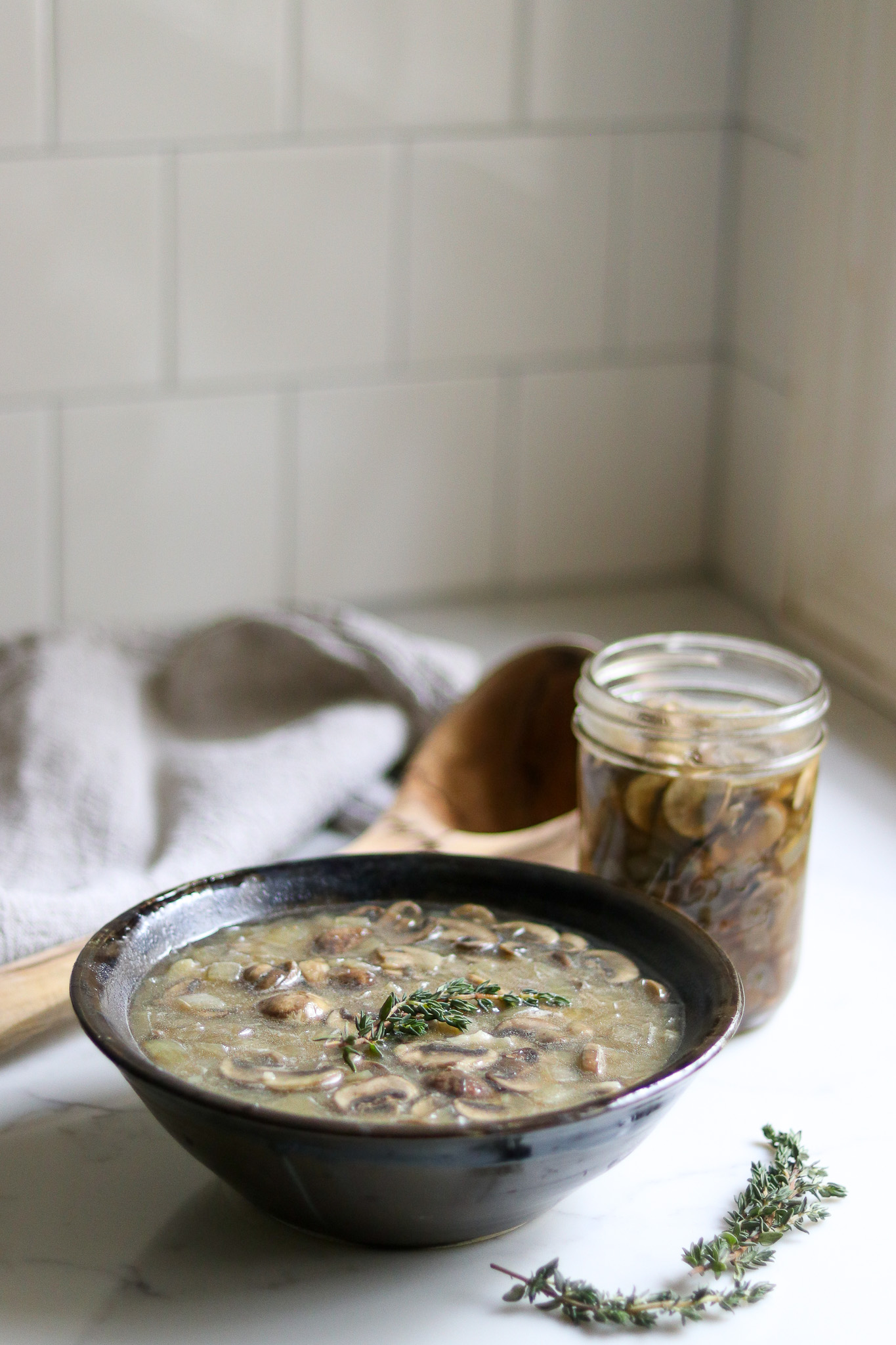
Soup Canning Recipes
There are so many different soup canning recipes out there, try these for your pantry:
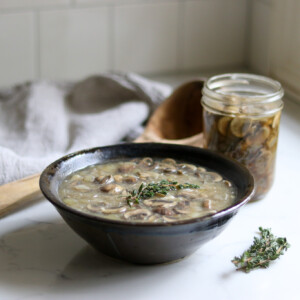
Canning Mushroom Soup Base
Equipment
Ingredients
- 4 tbsp butter
- 2 lbs mushrooms, thinly sliced
- 6 cloves garlic, minced
- 8 cups onions, minced, about 2 ¼ lbs or 1 kg of whole onions
- 1 cup dry white wine
- 8 cups broth, chicken broth, beef broth or vegetable broth
- 4 tsp canning salt
- 1 tsp ground black pepper
- 2 tsp dried thyme
- Boiling water to fill, may not be necessary, see notes
Instructions
- Prepare the jars and lids, putting them in the pressure canner with a few inches of water. Place on low heat to heat the canner up ahead of time.
- In a large stockpot, melt the butter and saute the onions and garlic for about 15 minutes.
- Add the mushrooms and saute for another 5 to 10 minutes until the mushrooms are browned.
- Add the wine, broth, and spices, bringing everything to a boil for five minutes.
- Remove from the heat and ladle soup into hot jars. Ladle solids first, then divide the liquid evenly among them. Leave 1" of headspace.
- Remove any air bubbles with a bubble removal tool, then ensure proper headspace. Add more broth or boiling water if needed.
- Wipe the rims of the jars, then put the lids and bands on the jars. Tighten until they are fingertip tight, then load into the pressure canner.
- Process the jars at 10 lbs of pressure for 45 minutes. You may need to adjust for altitude, see notes below.
- Let the canner depressurize on its own after the canning time has elapsed. Remove the jars and let them cool for 12 hours.
- Check the seals and store the jars for up to 12 months.
- Enjoy!
Notes
Yield
Be sure to evenly distribute all the solids across 8 canning jars (pints only). Once the solids are all in, top each jar with the flavorful broth, leaving 1'' headspace. You may need to add a bit of boiling water to top off the jars, and it's a good idea to have a kettle going, just in case.Altitude Adjustments for Canning Mushroom Soup Base
Canning time remains the same regardless of altitude. However, the processing pressure increases as altitude increase. Use the following table to determine the correct processing pressure if you’re above 1,000 feet in elevation.For dial gauge pressure canners:
- 0 to 2,000 feet in elevation – 11 lbs pressure
- 2,001 to 4,000 feet in elevation – 12 lbs pressure
- 4,001 to 6,000 feet in elevation – 13 lbs pressure
- 6,001 to 8,000 feet in elevation – 14 lbs pressure
For weighted gauge pressure canners:
- 0 to 1,000 feet in elevation – 10 lbs pressure
- Above 1,000 feet – 15 lbs pressure
To Serve
¼ cup (60 ml) heavy cream1 tbsp (8 grams) of flour for thickening
Fresh thyme or parsley, to taste To serve your soup, pour into a medium stock pot and heat it over medium heat for about 10 minutes, or until bubbling. Then, add the remainder of the ingredients (the cream and a flour slurry) to thicken the soup. Bring the soup back to a boil and cook for another minute or two to allow it to thicken up, being sure to stir it throughout the process. Garnish with thyme or parsley and serve with fresh bread or salad. Enjoy!
Nutrition
Nutrition information is automatically calculated, so should only be used as an approximation.
Canning Recipe Lists
Looking for more canning ideas?
- 100+ Canning Recipes from A to Z
- Pressure Canning Recipes
- Meat Canning Recipes
- Soup Canning Recipes
- Meal in a Jar Canning Recipes
- Vegetable Canning Recipes
- Fruit Canning Recipes
- Tomato Canning Recipes
- Zucchini Canning Recipes
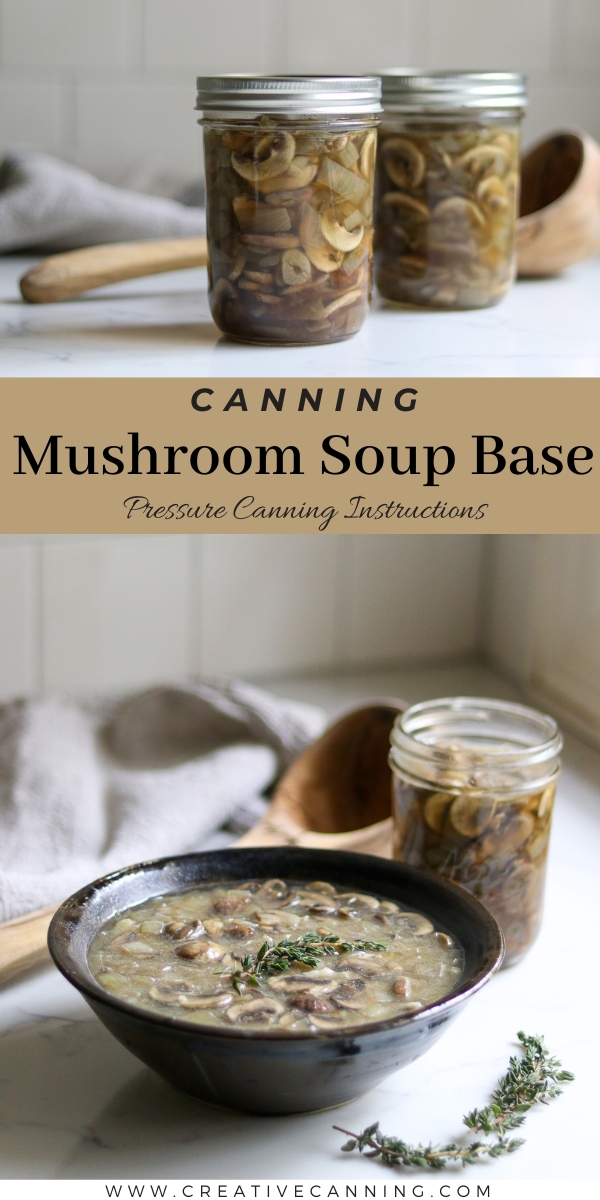
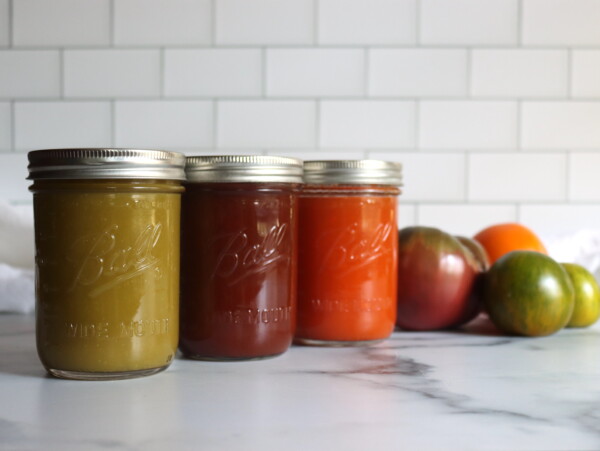
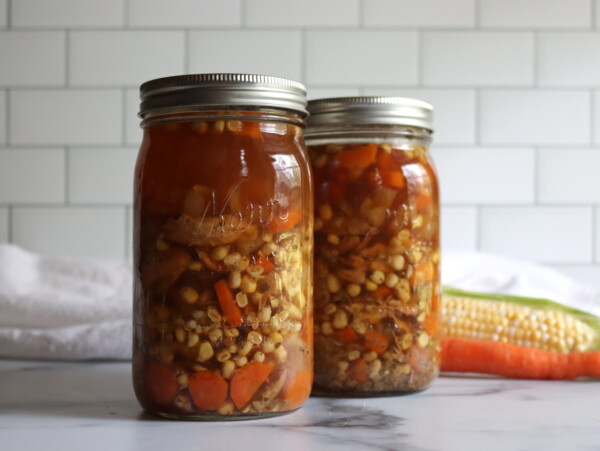
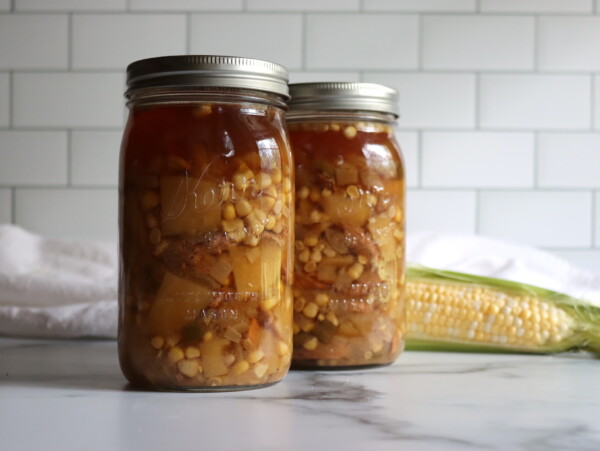
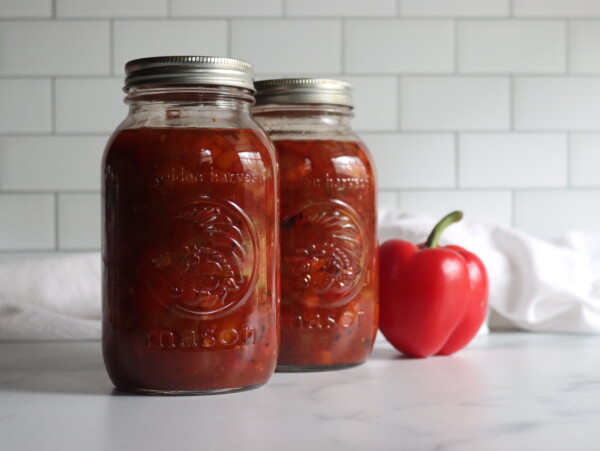
Can I water bath for canning. I don’t have a pressure canner
No, this is a pressure canning only recipe. Waterbath only works for jams, jellies and pickles, and other things that are acidic.
5 Stars and I haven’t even tried it. I think this is such a great plan. I do have mushrooms in the fridge and I will try this asap.
Thank you!
Lovely!
Thank you for the clear instructions on your website. One question – what can I substitute for he white wine in the mushroom recipe? I do not drink or cook with alcohol.
You can use water or stock in place of the white wine, either is fine. If you want to get that same flavor, add a tablespoon of champagne vinegar (or some other really mild salad vinegar) to the batch along with the water or stock you used to replace the wine. That’ll give it a similar flavor to a dry white wine.
Could you blend it smooth before canning?
I prefer a chunkless cream of mushroom soup.
You can’t blend it before canning unfortunately, as blended soups are not approved for canning. You have to blend it at serving time.
This looks delicious! Could I finely dice the mushrooms instead of slicing them or leaving them whole?
Yup, that’s fine!
Can you sub broth with vegetable bullion for a vegetarian version?
Yes, definitely!
Thank you so much for this recipe and detailed instructions! I made a double batch and tested the base by adding cream and flour. The result was amazing! Thank you again for allowing me to make and preserve a cream soup with known ingredients that are healthy and safe to consume.
So glad you enjoyed the recipe!